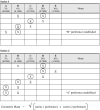Evaluation of the Monell forced-choice, paired-comparison tracking procedure for determining sweet taste preferences across the lifespan
- PMID: 21227904
- PMCID: PMC3073533
- DOI: 10.1093/chemse/bjq134
Evaluation of the Monell forced-choice, paired-comparison tracking procedure for determining sweet taste preferences across the lifespan
Abstract
Lack of methodology to assess taste in children limits its measurement in research studies that include pediatric populations. We used the Monell 2-series, forced-choice tracking method to measure sucrose preferences of a racially/ethnically diverse sample (n = 949) of children, adolescents, and adults. Reliability was assessed by comparing the results of the first series with the second series. Validity was assessed by relating participants' sucrose preferences to their preferences for foods varying in sweetness. The task required, on average, 7 presentations of aqueous sucrose solution pairs. Children and adolescents preferred more concentrated sweetness than adults (P < 0.001). Black children/adolescents preferred a more concentrated sucrose solution than did White children/adolescents even when gender, parental education level, and family income were used as covariates. Data from a single series were sufficient to detect age-related differences but insufficient to detect racial/ethnic differences in sweet preferences. Level of sweetness preferred significantly correlated with the sugar content of favorite cereals (P < 0.001) and beverages (P < 0.02). This method is brief and has evidence of reliability and external validity. Although a single series will yield useful information about age-related differences in taste preferences, the 2-series version should be considered when differences in race/ethnicity are of interest.
Figures

References
-
- Bacon AW, Miles JS, Schiffman SS. Effect of race on perception of fat alone and in combination with sugar. Physiol Behav. 1994;55:603–606. - PubMed
-
- Beauchamp GK, Cowart BJ. Preference for high salt concentrations among children. Dev Psychol. 1990;26:539–545.
-
- Bertino M, Beauchamp GK, Engelman K. Increasing dietary salt alters salt taste preference. Physiol Behav. 1986;38:203–213. - PubMed
-
- Bureau of the Census, USDoC. American Community Survey, Philadelphia City, PA. Bureau of the Census, Washington, DC. 2006–2008. Available from http://factfinder.census.gov.
Publication types
MeSH terms
Substances
Grants and funding
LinkOut - more resources
Full Text Sources
Medical

